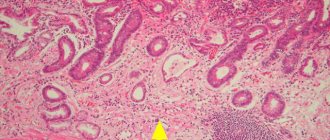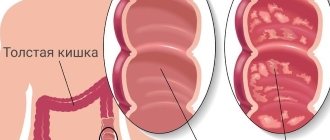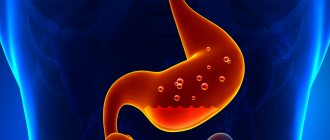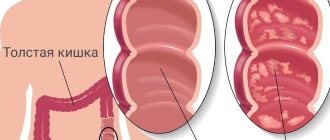- home
- Gastroenterology
- Treatment of gastritis of the stomach
- Treatment of atrophic gastritis of the stomach
Atrophic gastritis is one of the most dangerous subtypes of chronic gastritis, which can lead to the formation of cancer tumors. Most often diagnosed in the male half of the population. The disease is difficult to define due to a number of compensatory factors. Despite the complexity of this pathology, the specialists of our clinic have all the logistical capabilities to help every patient who comes to us with a similar illness.
What is this disease? Causes
Mucosal atrophy can have serious consequences
More often, atrophy of the gastric mucosa occurs in older people, but this does not mean that young people do not suffer from this disease at all. In 10% of cases, atrophic gastritis can be found in young people. In a young body, atrophic gastritis is practically not caused by factors such as poor diet and alcohol abuse, since it is a long-term chronic process. The most common cause is autoimmune diseases, as a result of which the immune system begins to destroy the body's cells, recognizing them as dangerous. Disruptions in the digestive system are inevitable. Gastritis often occurs with low acidity or a complete absence of hydrochloric acid in the gastric juice. Let's consider the main causes of atrophic gastritis:
- Improper and irregular nutrition. Long years of poor nutrition cannot but affect your health. Lack of diet, long hunger strikes or overeating, abuse of fatty, spicy, smoked, fried foods, fast food, soda - all this can lead to atrophy of the gastric mucosa.
- Alcoholism and smoking. Alcohol and tobacco smoke, entering the stomach, irritate the mucous membrane, damaging it. This can lead not only to atrophic gastritis, but also pancreatitis, ulcers, etc.
- Intoxication. The entry of poisons and other harmful substances into the body irritates the mucous membrane.
- Long-term use of drugs. Uncontrolled use of medications can also harm the stomach and intestines. This is especially true for aggressively active substances.
- Heredity. Hereditary factors also increase the risk of developing atrophic gastritis.
- A healthy lifestyle will help reduce your risk.
Chronic gastritis and stomach cancer
Gastric cancer is one of the most common malignant diseases in the world, where it ranks 5th in the structure of cancer diseases and 2nd in the structure of mortality from cancer pathology. In Russia, stomach cancer ranks fifth in the structure of incidence of malignant neoplasms in men and sixth in women.
The widespread prevalence of this disease and the low five-year survival rate (worldwide average is 10-20%) forces specialists around the world to actively search for algorithms for timely diagnosis of not so much stomach cancer as precancerous diseases.
Taking into account the location of the lesion, it is customary to distinguish two main types of gastric cancer: cardiac (damage to the cardiac region) and non-cardiac cancer (body and/or outlet of the stomach).
Chronic gastritis is a small step towards stomach cancer
This frightening subtitle quite accurately reflects the current understanding of the stages of gastric cancer development. The disease itself, “chronic gastritis,” usually does not cause obvious symptoms. But the presence of typical manifestations of the disease, such as abdominal pain, a feeling of heaviness, fullness after eating, nausea - these are symptoms of functional dyspepsia, which is still incorrectly defined not only by patients, but even by gastroenterologists as chronic gastritis.
So, chronic gastritis is a disease that does not manifest symptoms, and the diagnosis is confirmed only on the basis of histological examination of gastric biopsies. A morphologist performing the study can detect inflammation in the mucous membrane of varying degrees of severity. This is chronic gastritis.
In a certain proportion of people, prolonged inflammation in the gastric mucosa (chronic non-atrophic gastritis) can lead to the development of atrophic changes, and sometimes stomach cells can be replaced by atypical intestinal cells (so-called intestinal metaplasia).
Intestinal metaplasia increases the risk of developing dysplasia, a precancerous disease that over time can transform into adenocarcinoma (cancer) of the stomach.
These successive stages - chronic gastritis without atrophy, atrophic gastritis, intestinal metaplasia, dysplasia, gastric cancer - are called the “Correa cascade” after the author who described this sequence.
Causes of chronic gastritis
Since inflammatory changes in the gastric mucosa, i.e. gastritis is the initial stages of the development of stomach cancer, let's try to figure out where this disease comes from. It has long been proven that irregular meals, dry food and other eating disorders do not cause gastritis. Rather, these factors may contribute to the exacerbation of functional dyspepsia. Then what, figuratively speaking, adds firewood to the furnace of inflammation in the gastric mucosa?
To date, several factors have been identified that have been proven to cause the development of inflammation in the stomach:
- infection, especially Helicobacter pylori (H. pylori) infection;
- autoimmune inflammation;
- inflammation in response to chemical damage (for example, bile in duodeno-gastric reflux).
Of course, there are other reasons, but their contribution to the development of inflammation in the stomach can be considered insignificant.
H. pylori infection is currently considered to be the main factor causing the development of chronic gastritis. About 44% of the world's population is infected with this pathogen. It is known that the prevalence of atrophic gastritis against the background of H. pylori infection varies from 8% in Western countries to 84% in Japan and China. H. pylori is considered the most significant risk factor for the development of non-cardiac gastric cancer.
Autoimmune inflammation is much less common, but also leads to the development of chronic gastritis, often with atrophy, and is associated with an increased risk of developing stomach cancer.
Risk factors for developing adenocarcinoma (cancer) of the stomach
1) Hereditary predisposition.
It is known that the risk of developing stomach cancer in first-degree relatives (parents, children) is increased by 2.3-3.5 times. If you indicate 2 or more cases of stomach cancer in close relatives, this risk increases by 5-12 times. The risk is higher in cases where gastric cancer was detected in relatives aged less than 50 years.
2) Autoimmune damage to the stomach with the development of pernicious (B12-deficiency) anemia.
Autoimmune damage to the stomach, in addition to the development of atrophy, is also characterized by the destruction of the internal factor (Castle factor), which ensures normal absorption of vitamin B12 in the small intestine. It has been established that autoimmune gastritis increases the risk of developing adenocarcinoma (cancer) of the stomach by 2-6.8 times.
3) Ethnic factors.
It has been established that the risk of developing stomach cancer is higher in Asians compared to whites (2.1 times) and blacks (1.7 times). Among people of Asian race, the highest risk was observed in Chinese (4.77) and Koreans (7.39). It cannot be excluded that this difference is due, among other things, to the high frequency of H. pylori infection in these individuals and genetic characteristics.
4) Older age.
There is evidence that the risk of developing stomach cancer varies across age groups. “Borderline” age is considered to be over 45 years of age, after which the risk of developing the disease increases by 1.92-3.1 times. Most likely, this relationship is due to the duration of H. pylori infection and the resulting chronic inflammation
5) Male gender.
According to research, men have a greater risk of developing adenocarcinoma (cancer) of the stomach compared to women, and the risk is increased by 1.3-3 times.
6) Tobacco smoking.
Smokers have an increased risk of developing stomach cancer localized in the cardiac region. The likelihood of developing the disease increases by 1.45-2 times according to various studies.
7) H. pylori infection.
Apparently, this is the most significant risk factor for the development of stomach cancer, given the widespread prevalence of this infection throughout the world. Studies have shown that the risk of developing non-cardiac gastric cancer in infected individuals is increased by 12 times. Approximately 1% of them develop gastric adenocarcinoma during their lifetime. The risk of developing gastric cardia cancer does not increase.
Stomach polyps.
Gastric polyps are divided into 3 types: fundic polyps, hyperplastic polyps and adenomatous polyps. In polyps of the fundic glands measuring more than 1 cm, it is rare, but dysplasia and cancer are detected (with a frequency of 1.9%, respectively). Hyperplastic polyps of large (>1 cm) sizes are characterized by frequent detection of dysplasia (1.9-19%) and, less commonly, malignant degeneration (0.6-2.1%). Adenomatous polyps significantly increase the risk of developing gastric adenocarcinoma, and when polyps are >2 cm in size, the frequency of detection of adenocarcinoma in them reaches, according to some data, 50%.
9) Atrophic gastritis.
Since atrophic gastritis is one of the stages in the “Correa cascade” (see above), the risk of its transformation into gastric cancer was assessed. According to modern data, the annual risk of transition of atrophic gastritis to gastric cancer is 0.1-1.2%. The 5-year incidence of gastric cancer in patients with atrophy ranges from 0.7% (mild atrophy) to 10% (severe atrophy).
10) Intestinal metaplasia.
Like atrophic gastritis, intestinal metaplasia is one of the stages of the “Correa cascade” on the path to the development of gastric cancer. The annual risk of progression of intestinal metaplasia to gastric cancer is 0.25-0.4%. The detection rate of gastric cancer in patients with intestinal metaplasia within 5 years is 5.3-9.8%.
11) Dysplasia.
Dysplasia (precancerous condition) is divided into two types: low and high grade. Low-grade dysplasia has an annual risk of transformation into gastric cancer of 0.6%, while for high-grade dysplasia it is 6%.
The detection rate of gastric cancer in patients with low-grade dysplasia within 5 years is 0-23%, high-grade - 60-85%.
Recommendations for preventing the development of adenocarcinoma (cancer) of the stomach
During 2022, recommendations for the diagnosis and treatment of patients at high risk of gastric adenocarcinoma (cancer) were published by two groups of authors: the British Society of Gastroenterology and a panel of scientists represented by members of the European Society of Gastrointestinal Endoscopy, the European Group for the Study of Helicobacter pylori and Microbiota, the European Society pathologists and the Portuguese Society of Gastrointestinal Endoscopy (the so-called international recommendations for the treatment of precancerous conditions and changes in the stomach, second revision (MAPS II). Recommendations were given to prevent the development and timely detection of a terrible disease - gastric cancer.
So, what are the recommendations for preventing stomach cancer?
1) Patients with chronic atrophic gastritis or intestinal metaplasia are at risk of developing gastric cancer.
Comment : The greatest risk is observed when atrophy/intestinal metaplasia is detected simultaneously in the antrum and body of the stomach.
2) Persons living in areas with a high incidence of gastric cancer should be tested for H. pylori infection.
Comment : Reliable diagnostic methods should be used, including a C13-labeled urea breath test, determination of H. pylori antigen in stool or H. pylori IgG antibodies in the blood. Russia is one of the regions with a high prevalence of stomach cancer.
3) Asymptomatic individuals aged ≥50 years with multiple risk factors (male gender, tobacco smoking, family history of gastric cancer, etc.) should undergo screening gastroscopy.
Note : screening in medicine is a set of measures aimed at identifying a disease that does not manifest itself in any way. In this case, we are talking about performing gastroscopy on people without symptoms of stomach cancer.
Very important! There are several types of hereditary gastric cancer, which are characterized by earlier onset (before the age of 40 years).
4) Persons at high risk of developing stomach cancer (including gastritis with atrophy and intestinal metaplasia) require regular gastroscopy with photographic recording and histological examination.
Comment : according to foreign studies, stomach cancer is undetected during gastroscopy in 6-11% of cases. It is very important to slowly examine the gastric mucosa and record images (photos, videos), which increases the detection of early gastric cancer. At the Expert clinic, video recording of all endoscopic examinations of the gastrointestinal tract is carried out on a mandatory basis.
5) For patients with widespread atrophy and intestinal metaplasia (involvement of the antrum and body of the stomach), regular gastroscopy with biopsy is indicated.
Comment : The frequency of gastroscopy depends on many factors, including a family history of gastric cancer, persistence of H. pylori infection despite adequate treatment, etc.
6) Persons with chronic gastritis or gastritis with atrophy due to H. pylori should undergo eradication therapy for the infection.
Comment : prevention of the development of gastric cancer is most effective in cases where the patient began to be treated for H. pylori infection at the stage of identifying non-atrophic gastritis or gastritis with atrophy.
7) Treatment of H. pylori infection may be effective in preventing the development of gastric cancer in a proportion of patients who already have intestinal metaplasia, dysplasia or gastric cancer.
Comment : Treatment of H. pylori infection in patients with intestinal metaplasia and dysplasia, as well as in those with endoscopically resected gastric adenocarcinoma, reduces the risk of development/recurrence of gastric cancer. However, the preventive effect of treatment at these stages is less than with chronic non-atrophic or atrophic gastritis.
Conclusion
Timely and adequate diagnostics at the stage of “simple gastritis”, i.e. before the development of atrophy/metaplasia/dysplasia, it allows you to determine the risks of developing gastric cancer pathology and choose the right tactics to avoid the development of a terrible disease.
Symptoms of atrophy of the gastric mucosa
Symptoms of atrophy of the gastric mucosa are varied, among them pain
There are a number of signs that you should pay attention to in order to avoid such an unpleasant disease as atrophic gastritis. It simply needs to be treated, as it can cause cancer.
- Nausea. Nausea often accompanies atrophic gastritis. It serves as a sign of inflammatory processes in the stomach.
- Bad breath. Bad breath, or cacosmia, is an invariable attribute of any gastritis. Brushing and rinsing usually does not help, as the odor comes from the esophagus.
- Belching with bitterness. Due to insufficiently concentrated gastric juice after eating, belching may occur with bitterness and an unpleasant odor of undigested food.
- Unstable chair. Constipation alternates with diarrhea. This extremely unpleasant phenomenon is caused by impaired intestinal function due to poor digestion of food in the stomach.
- Feeling of heaviness in the stomach. Food is digested poorly and slowly, so even with a small amount of food the patient has a feeling of heaviness in the stomach. For this reason, people suffering from atrophic gastritis eat little and rapidly lose weight.
- Bloating. Bloating, as well as unstable stools, are associated with intestinal dysfunction due to poorly digested food. Increased gas formation, as well as insufficient intestinal motility, can accompany atrophy of the gastric mucosa.
- White coating on the tongue. White plaque appears during periods of relapse of the disease.
- Aching pain in the abdomen. The pain may be constant or appear periodically. Pain often occurs after eating.
- Weight loss. Weight loss is associated both with general weakening of the body and with a feeling of discomfort after eating. The patient notices that after eating his condition worsens, nausea, a feeling of heaviness, belching and other troubles appear. This causes a decrease in appetite.
- Deterioration of the general condition of the body. Atrophic gastritis weakens the entire body as a whole. Immunity may decrease, anemia may develop, hair loss, and the condition of the nails may deteriorate.
Treatment of atrophic gastritis in Israel – prices
The cost of diagnostic and therapeutic procedures in Top Ikhilov is much lower than in clinics in the West - up to 35-50%. This is our main difference from European and American medicine.
Choose Top Ichilov - a clinic of affordable innovations
- Many years of experience of doctors in the treatment of gastroenterological diseases.
- Informative and high-tech examination methods, effective and low-traumatic methods of therapy.
- Accurate diagnosis in 3-4 days.
- Affordable prices for examination and treatment.
- Complete care for each patient - organization of stay in the country and clinic. The international department will solve all your questions related to accommodation, transfer, food, as well as examination and treatment. With us you will not have insoluble problems.
- 5
- 4
- 3
- 2
- 1
(74 votes, average: 4.9 out of 5)
Treatment of atrophy of the gastric mucosa
Treatment of atrophy of the gastric mucosa should begin immediately when the first symptoms appear. Treatment should be prescribed by a doctor after a thorough examination and diagnosis. Self-medication is dangerous due to the potential development of stomach cancer. Complex treatment is usually recommended, consisting of drug therapy, folk remedies and a special diet. Let's consider the main points of drug treatment of atrophic gastritis:
- Medicines that relieve pain. The doctor can prescribe both anticholinergics and antispasmodics. The latter include No-Shpa, Papaverine. They relieve spasms and sharp pain in the abdomen. Anticholinergics, such as Metacin, Gastrocepin, also help with severe pain. They block the action of acetylcholine, resulting in reduced pain and decreased gland secretion. This is fraught with some side effects, such as dry skin, a feeling of dry mouth.
- Drugs that stimulate the functioning of the stomach muscles. Such drugs include Cerucal, Motilium, which improve the motor activity of the stomach. These medications also have an antiemetic effect and relieve nausea. They have their side effects. Motilium, as a rule, is more easily tolerated than Cerucal. They should not be taken during lactation, intestinal obstruction, or gastric bleeding.
- Enzymes and replacement drugs. Since atrophic gastritis is often accompanied by other diseases related to digestion, the doctor may prescribe pancreatic enzymes (Pancreatin, Creon). They help digest food. Also, with low acidity of gastric juice, insufficient concentration of hydrochloric acid in the stomach, Abomin or Pepsidil are prescribed.
- Vitamin therapy. Vitamins will help maintain the general condition of the body and cope with anemia. For this purpose, folic acid, B vitamins, and iron supplements are prescribed.
- Spa treatment and mineral waters will also be useful for gastritis. Holidays in Kislovodsk and Pyatigorsk will be beneficial.
Atrophic gastritis symptoms and treatment in adults
Symptoms and treatment of atrophic gastritis depend on a number of specific factors. All of them relate directly to the patient himself. This is the degree of neglect of the disease, the patient’s bad habits, lifestyle, general health and age-related changes in the digestive system.
Signs of the disease:
- belching, present both on a full and empty stomach;
- nausea, turning into a full-fledged urge to vomit;
- severe putrid odor from the mouth, but at the same time the patient does not have dental problems or infectious diseases of the throat;
- incessant overflow and rumbling inside the abdominal cavity are heard;
- increased gas formation and flatulence;
- disturbance of bowel movements towards constipation (diarrhea is much less common);
- total body weight decreases;
- hormonal metabolism and vitamin balance are disrupted;
- as stomach tissue changes, body temperature may rise to 37 degrees or higher.
If you notice these painful signs, you should immediately contact the specialists of our clinic in order to promptly prevent the possible onset of the development of an oncological process in the main organ of the digestive system.
Folk remedies and diet
Diet is a prerequisite for stomach treatment
Diet is an integral part of treatment. Since the gastric mucosa is affected, all food should be light, prepared without the use of oil, in order to reduce the load on the sore stomach. Coarse fibers should be excluded. It is advisable that the food be finely chopped or twisted. It is necessary to monitor the temperature of food. You will have to give up everything hot and cold. Dishes should only be warm.
All products containing spices, seasonings, carcinogens, large amounts of salt, smoked foods, carbonated and alcoholic drinks, canned food, cream cakes, chocolate, homemade and store-bought pickles are prohibited. Fried foods and fatty meats should also be excluded from the diet. Meat dishes should be lean and steamed. Boiled vegetables are better. Low-fat and non-acidic dairy products are allowed. You can use pureed soups made from vegetables, without meat broths or frying. Drinks allowed are non-acidic natural mousses and jelly, still mineral water, and weak tea. \
Remember that medicinal mineral water, which is sold in pharmacies, cannot be drunk unlimitedly. This is a medicine containing a certain amount of substances and minerals. The dosage is determined by the doctor.
Try in every possible way to increase your appetite to prevent exhaustion. Let the dishes be served beautifully; they should look attractive to you even without spices and mayonnaise. As an additional treatment, your doctor may prescribe herbal teas or tinctures of herbs that improve digestion. So, for atrophic gastritis, a mixture of calamus rhizome, honey and cognac, as well as St. John's wort, plantain, yarrow, peppermint, cumin, flax seed, sage, dill is useful. Natural blueberries, ground with sugar, will help restore the gastric mucosa. You need to take a teaspoon on an empty stomach in the morning. But the berries must be fresh. Jam will not give the desired effect, since most vitamins are destroyed during heat treatment.










